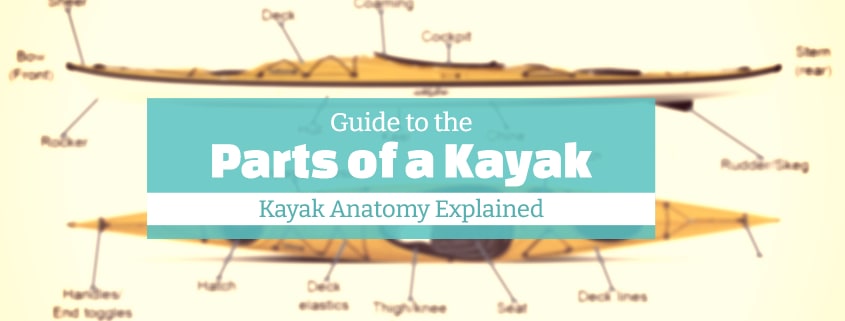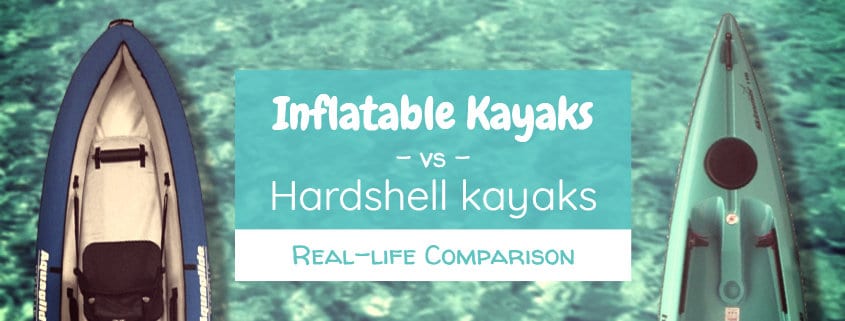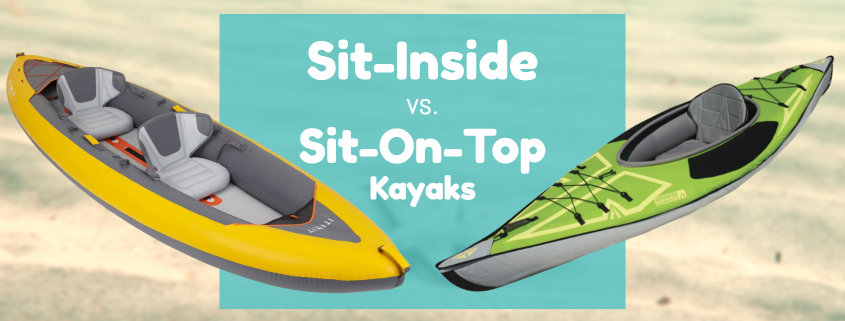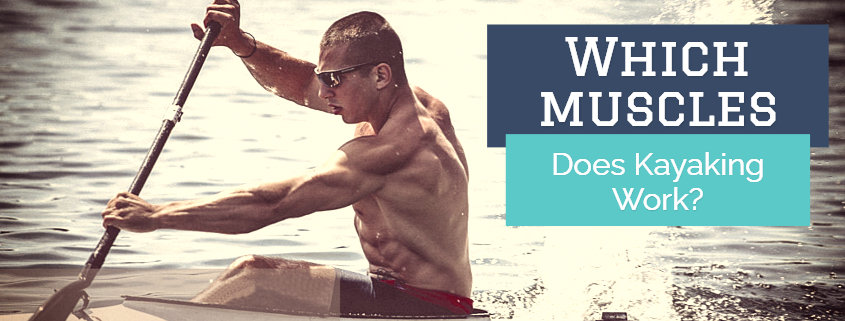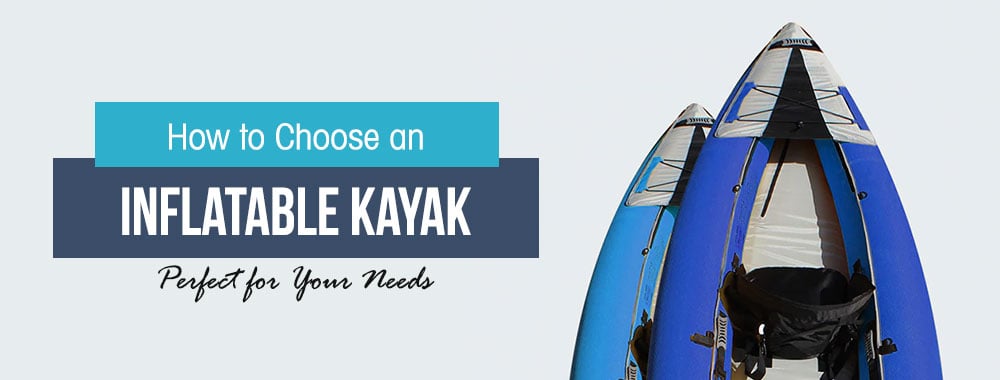Becoming a proficient paddler involves getting familiar with the anatomy of a kayak.
Don’t worry. It’s not that complicated, but very useful nonetheless.
The anatomy of both inflatable and hard-shell kayaks is similar, so I won’t list them separately in this regard. I’ll list their differences instead.
Contents
Main Body Parts of a Kayak
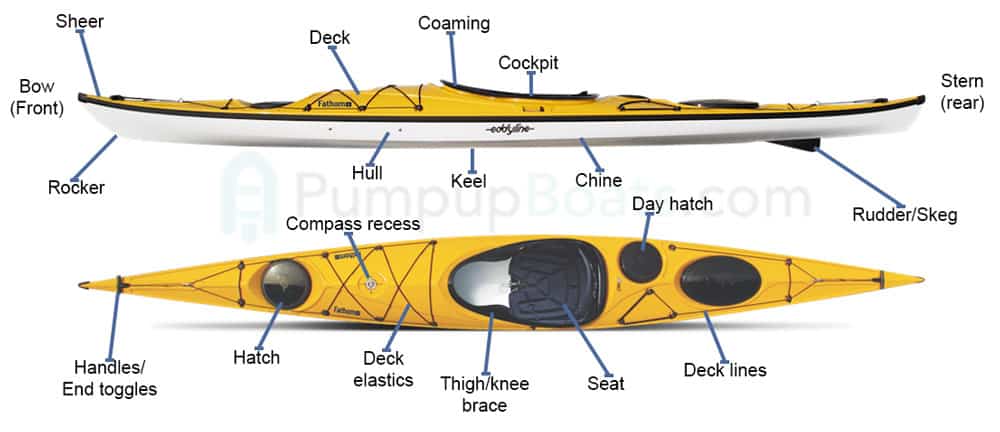
Bow:
The front part of the kayak is known as the bow.
Stern:
The rear part of the kayak is known as the stern.
Deck:
The upper part of the kayak on which you sit or store something is known as the deck.
Hull:
The bottom side of the kayak is known as the hull. There are several different types of hulls, the most popular being:
- Displacement hull: A displacement is a V-shaped hull with a centreline running from front to back. Kayaks with such hulls can achieve high speeds and travel in a straight line, meaning they track well.
- Planing hull: A planing hull is present in whitewater kayaks. They consist of a flat bottom and sides that are quite steep. They might not be able to achieve high speed, but they provide skilled paddlers with excellent controllability.
Chine:
Chine is the part of the kayak, which connects the hull’s side to the hull’s bottom. A kayak can consist of one chine on each side or even more than one. It depends on the design of the kayak.
Keel:
The keel is the straight centreline of a displacement hull, which runs from the bow to the stern. The purpose of the keel is to help keep the kayak going in a straight line.
Sheer:
The sheer is the part of the bow and stern that sweeps upwards. It remains above the waterline at all times.
Rocker:
The rocker is the upper part of the keel line that extends towards the bow and stern of the kayak. A kayak without a rocker is entirely flat from stern to bow. More rocker makes it easier to turn the kayak. Less rocker means faster speeds and better tracking.
Common Kayak Parts
These are the elements that both sit-inside and sit-on-top kayaks share.
Deck fittings:
Deck elastics, deck lines, and other fixtures on the deck are the deck fittings. These usually are attachment points to store various things.
Deck elastics:
These are nothing but bungee cords inside which you can store smaller items that will not slip through the net. You can easily attach water bottles, bags, and other such accessories to store things using deck elastics.
Handles:
Carry handles make it possible to carry the kayak to and from the water. Most kayaks have handles on both the stern and bow.
Seat:
The seat, as the name itself suggests, is the seat which the kayak offers. Some kayaks have removable seats, but some are built-in. The seat can vary in material and firmness: they may be rigid, inflatable, reclinable, removable, etc.
Footrests:
Footrests can also be called foot pegs and foot braces. They provide a fixed surface to push against while paddling the kayak. These help you in balancing and controlling your boat. Footrests can be adjustable or stationary.
Skeg:
A skeg is a fin underneath the hull, usually found near the stern side. Inflatable boats typically have 1-4 removable skegs.
Rudder:
The rudder helps keep your kayak going straight and in controlling its direction. You control the rudder with foot braces. Most rudders can be flipped up and deployed as you need them.
Rudder Uphaul:
Rudder uphaul is nothing but a rope you can use to deploy the rudder or pull it back up. It can come in the form of a lever as well.
Sit-inside Kayak Parts
The parts of the kayak which we will highlight now are particular to sit inside kayaks.
Cockpit:
The cockpit is the space inside which you sit in the kayak. It is more spacious in recreational kayaks than in touring & whitewater kayaks. A larger cockpit is more comfortable because it makes entering and exiting the kayak easier. However, the larger cockpit also makes the kayak bulkier and slower.
The smaller cockpits make it easy for you to gain control, do Eskimo rolls, and achieve higher speeds.
Cockpit rim:
The cockpit coaming (aka rim) refers to the raised outer edge of the cockpit edge. You can attach a sprayskirt to the coaming, which keeps water out of the cockpit.
Hip pads:
Hip pads are removable pads placed at the seat’s side edges to cushion your hips and make sure you don’t shift around while paddling. You can find them in sea kayaks and whitewater kayaks.
End toggles:
End toggles are a safety feature of kayaks. They hang off the end of a kayak and provide something to hold on to if you are in the water.
Deck Lines:
Deck lines are nothing but ropes running around the kayak’s perimeter. You may grasp them to get a better grip of the boat when you need to empty the kayak or possibly during a rescue.
Compass recess:
When you’re taking the kayak out on the sea, navigation is essential. The compass recess is a slot where you can place a standard-sized sea compass.
Backband:
You can find a backband in whitewater and sea kayaks. It is a low backrest that aims to help you gain proper posture without getting in the way of your torso during paddling. When you’re going on an extended kayaking trip, a backband becomes essential.
Bulkhead:
The bulkhead is a wall responsible for dividing the kayak into separate parts. It can create watertight compartments in the kayak for dry storage and increases the buoyancy of the kayak.
Hatches:
A hatch is the opening of the dry compartment of the kayak. You can use the dry area for storing the things that you want to carry with you. The job of the hatch is to close the compartment appropriately so that water does not go inside.
Day Hatch:
A day hatch is a compartment that is behind the cockpit, within easy reach of the paddler. It is smaller than the other hatches.
Thigh Braces:
Thigh braces are responsible for becoming one with your kayak by making proper contact between your thighs and knees. When you’re out on the sea or in a whitewater kayak, thigh braces become a necessity to control your kayak and to stay in it.
Paddle float rigging:
A paddle float is something you can attach to your paddle to make it float. On kayaks with paddle float rigging, your paddle float can be attached to the kayak and act as an outrigger, making self rescues much easier.
Now that you know what parts make up a sit-inside kayak, it is time to look at inflatable kayaks’ various components.
Sit-on-top Kayak Parts
The parts of the kayak which we are highlighting now are particular to sit-on-top kayaks. These include:
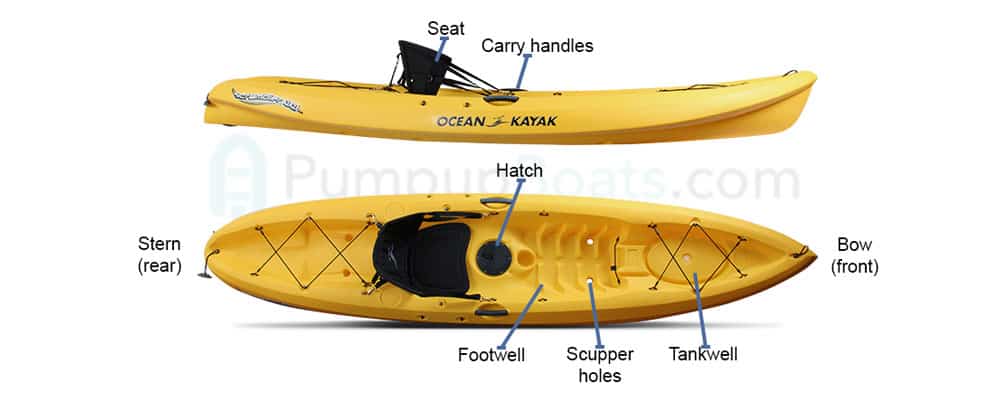
Scuppers:
Scuppers are holes on the sit-on-top kayak which let the water drain through. They come in handy when water splashes onto the deck. Scupper holes can usually be closed off if you don’t need to use them.
Footwells:
Some sit-on-top kayaks have footwells integrated into the body of the kayak, making them your foot braces. They present themselves as a series of bumps molded into the deck, so paddlers of different heights can find a suitable footwell position. Longer-legged kayakers will choose a footwell further away from them, while shorter ones will choose a closer footwell.
Pedal-drive:
Some kayaks consist of a propeller or a flipper-type pedal drive. These allow you to propel the kayak using your legs rather than the paddle. When you’re storing the kayak or using the conventional paddle to move it, you can remove these pedal drives.
Rod holder:
Rod holders can hold your fishing rod in place, so you don’t always need to keep it in your hands. Most fishing kayaks will have several rod holders integrated into the boat. If yours doesn’t, you can get attachable rod holder accessories like these.
Accessory Rails:
Accessory rails allow you to customize the kayak. You can easily use these rails to add rod holders, fish finders, and many other accessories. In a nutshell, you can customize the kayak based on your requirements.
Tankwell:
The tankwell (aka deck well) is an area on the deck of sit-on-top kayaks where you can store large items like a scuba tank, a crate, dry bags, and so on. It is generally near the stern of the kayak.
Inflatable Kayak Parts
The following are parts of inflatable kayaks specifically. You will not find them on hard-shell kayaks.
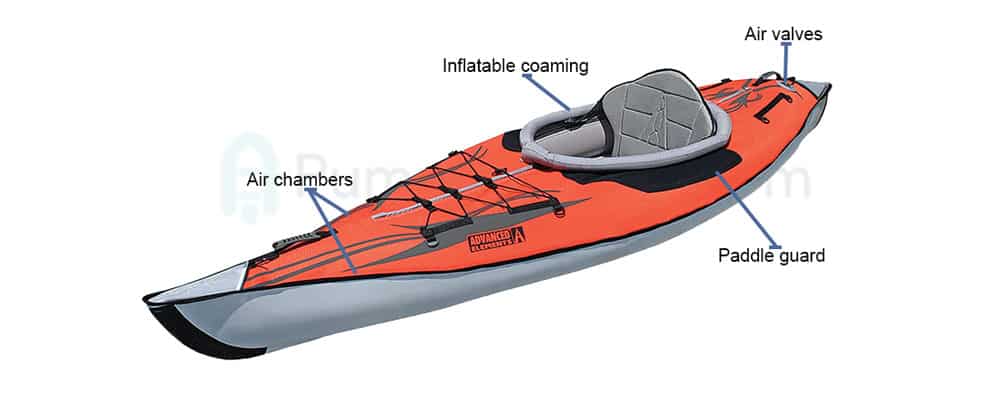
Air chambers:
Inflatable kayaks are always at the risk of punctures and holes. The problem is that when a tube punctures, it will start to lose air. This is where the idea of multiple air chambers comes into the picture.
Air chambers refer to separate pockets of air inside the body of the kayak that are not interconnected. In that way, if a single section suffers a puncture, it will not sink the entire kayak. The remaining air chamber’s buoyancy will keep it afloat, giving the paddler time to get to safety.
Valves:
Air chambers are inflated and deflated through valves. There are several different types of valves used on inflatable kayaks. The better ones are one-way valves, like the Halkey Roberts valve or the Boston valve.
Now that you know the various parts of the kayaks, you can accurately buy the right one. Once you know your kayak inside out, you can undoubtedly enjoy your kayaking experience in a much better way.
Paddle guard:
Inflatable kayaks sometimes have an extra layer of abbrasion resistant material on the side of the cockpit, which guards the body of the kayak against damage from the paddle during paddling.
Inflatable coaming:
Some sit-inside inflatable kayaks have coaming running around the cockpit, which requires inflation to become rigid. You can attach a spray-skirt to an inflated coaming, just like on a hard-shell kayak.

